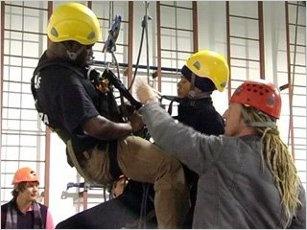Fall arrest and rope access training courses ensure safety of staff members working at more than two metres above ground
Fall arrest training is essential to the day-to-day safety of all workers in South Africa who are carrying out tasks more than two metres above the ground, according to height safety consulting and training provider, Height Wise Training Academy.
Height Wise director Penny Fabricius highlights the fact that this stringent law is enforced by the Occupational Health and Safety Act (OHSA) of 1993. “A considerable amount of workers in South Africa are exposed to varying degrees of work at height, and it is the responsibility of the employer under the OHSA to ensure that all employees obtain basic, yet life-saving skills, for the work environment.”
Training successes
Fabricius points out that Height Wise has to date trained more than 1,200 people from numerous industries including mining, telecommunications and the energy sectors of Africa in the basic principles of fall arrest systems, which are all compliant with the Institute for Work at Height (IWH) and National Qualifications Framework (NFQ) standards.
“The IWH was formed as a result of the merger between the Specialised Manufacturers Association (SAEMA) and the Rope Access and Fall Arrest Association (RAFAA), and is currently working with the Department of Labour to establish a professional body for the work at height sector of South Africa,” she continues.
“By providing training courses that are IWH-approved, Height Wise is providing trainees with the peace-of-mind that they are receiving the highest-quality of standards in safety training.”
A viable profession Fabricius points out that being a freelance rope access technician is a viable occupation in Africa, where skilled and qualified trainees can earn more than R1 500-per-day. She does; however, admit that extensive training must first be undertaken.
This includes:
Level 1: Enables the trainee to perform a limited range of rope access tasks and rescues. In order to move from a Level 1 to a Level 2 rope access technician, the trainee must complete a minimum of 750 logged working hours.
Level 2: Trainees completing Level 2 will be provided with a Height Wise certificate, which qualifies them to manage the safety of personnel working at height. A minimum of 1,000 working hours must be logged to qualify for Level 3 training.
Level 3: This is the highest level of rope access training and all supervisors are required to be Level 3 qualified. This enables them to supervise rope access teams, and to perform advanced manoeuvres and rescues onsite.
“Rope access training is complex and demanding, and the OHSA states that only persons 18 years and older, who are both medically and psychologically-fit, can qualify for the intensive training,” says Fabricius. “Trainees who meet these criteria are then provided with world-class training from expert rope access technicians employed by Skyriders, who have extensive experience in various industries across Africa.”
Looking to the future, Fabricius notes that the rapid development of industries across Africa serves as a potential platform for growth.
“As industries continue to expand, so too will the demand for safety training. Height Wise has distinguished itself as a reputable leader in providing at height safety solutions training, and I believe that the company is in prime position to gain significant market share, and to establish new training academies across the continent,” she concludes.




